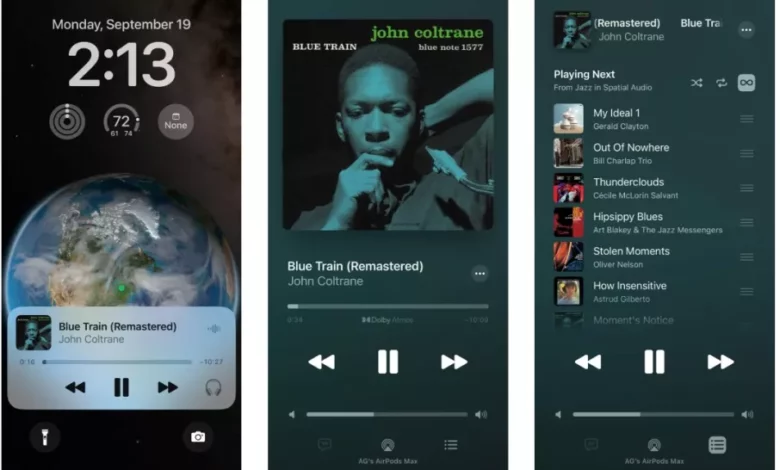
The official arrival of iOS 16 has made a handful of audio upgrades available to iPhone users, the key one being Personalized Spatial Audio, a feature that taps the iPhone’s TrueDepth camera to create a profile tuned for the listener’s ears when using AirPods Pro (1st or 2nd generation), AirPods Max, AirPods 3, or Beats Fit Pro headphones. Apple Music subscribers should by now be well-acquainted with the benefits of Spatial Audio, but there are other Apple Music-specific features arriving with iOS 16 that make the service easier and more enjoyable to use.
Full-screen music player
When playing tracks in Apple Music, the app’s lock screen widget now shows which Apple devices (e.g., AirPods Pro, AirPods Max) are connected via Bluetooth. But that’s just a minor change. You can now press on the widget and it expands, giving you a full-screen view of the album cover art, along with controls like a button to jump to the Playing Next screen and the “3 dots” that call up options to Add to Library or Playlist, Show Album, Create Station, and Love (or dislike) tracks.
This change isn’t a huge one by any means, but it does improve the speed with which you can carry out multiple Apple Music functions on your phone. More importantly, it works the same for some of the other best music streaming apps like Tidal and Spotify, along with internet radio and podcasting ones.
Expanded volume HUD
Another Apple Music tweak – and one that you’ll see when you tap to access that full-screen player – is an expanded volume HUD. The volume slider now matches the full width of the track playback bar, which is not just an aesthetic improvement, but one that makes adjusting volume easier and allows for more granular loudness changes. The bar also swells up and illuminates as you make adjustments, which further improves usability.
Is this a consequential change? Not necessarily, but I often find myself frustrated with the lack of onscreen controls to adjust volume in apps, a situation that leads me to – gasp! – press the hardware volume up/down buttons on the iPhone’s side panel. Notably, because the Tidal music service that I also use regularly has no volume slider on its full-screen iOS app, I’m required to make multiple screen presses to access that control. So the new expanded and easily accessible volume control slider is a good example of why Apple Music rocks.

Playlist sorting
Another useful feature that has been added to Apple Music with iOS 16 is playlist sorting. Previously, playlists created in the app reflected the order in which tracks were added to it: first track first, last track last. Now, hitting the three dots button at the top of the Apple Music screen in Playlist view calls up a Sort control with Title, Artist, Album, and Release Date options. Oh yeah, and there’s also an option to revert back to your original playlist order.
Why is sorting playlists important? I have a massive playlist that I created in the early days of the pandemic when there was suddenly time to do such things. It’s basically the soundtrack to my life and reflects the music that was most important to me at various stages from childhood to the present. After upgrading to iOS 16, I immediately thought of a use for the new sorting feature, which would let me listen to those tracks in chronological order. That’s something I had previously wanted to do, but then found myself without the time (or will) to reorder the tracks in a new playlist.
Another iOS 16 audio change
While there are multiple other updates to Apple Music, they’re almost too inconsequential to mention. But there’s one overlooked iOS 16 audio update I feel is worth pointing out, mainly because it’s something I’m certain to make use of. When you ask Siri voice control to tell you the name of a song that’s playing, that info now syncs with the Shazam music recognition app. Not only that, but it also syncs with Music Recognition in the iOS Control Center, so you can quickly access a list of songs you’ve searched via either means by pressing that icon.
Yet again, not a game-changing update, but a thoughtful and meaningful one from Apple.
By Al Griffin







